

 |
| Number 23, February 2001 |
 |
 Good PROSPECT
Good PROSPECT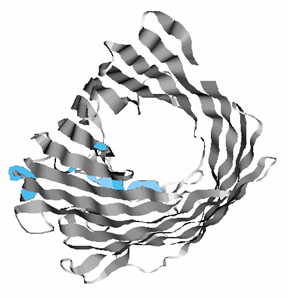 |
| A predicted protein structure the Life Sciences group modeled for CASP. |
A Life Sciences Division group has placed high in an international competition to predict, through computer modeling, one of the most complex puzzles nature presents to scientists—how a protein will fold itself into a convoluted yet meaningful tangle.
Predicting those protein structures is the key to understanding gene function and putting to work the vast body of knowledge attained from the mapping of the human genome.
Life Sciences’ Computational Protein Structure group—Dong Xu, Oakley Crawford, Phil LoCascio and Ying Xu—placed sixth out of 123 teams that entered the Fourth Critical Assessment of Techniques for Protein Structure Prediction Experiment, called CASP. The competition tests researchers’ ability to predict how a strand of complex protein, which is represented by a long sequence of letters representing amino acids, will fold itself into a shape that often resembles an expensive bow on a birthday present.
Group leader Ying Xu says those shapes aren’t as random as they seem. Physical forces determine that shape, and how the proteins are shaped determines their functions and properties.
“Protein amino acids have potential energy—the atoms have charges,” he explains. “A protein folds a certain way because of the plus and minus charges and other factors, such as how its amino acids react to water. The folding problem then becomes a mathematical problem: We solve for the folded state with a minimal energy because the protein will naturally fold in a way that minimizes the potential energy.”
The Life Sciences group has developed a computer program called PROSPECT. The PROtein Structure Prediction and Evaluation Computer Toolkit enables them to predict in three dimensions what shape a protein sequence—the strand of protein represented by the line of letters—will assume. Proteins fold into complex shapes, creating “active areas” or sites that enable the folded proteins to interact with other proteins. Those interactions accomplish a complex biological function, much in the way that the gears in a watch mesh together into a functioning machine.
“A gene is translated into a protein sequence, and then the structure of that sequence is determined. From the shape of those protein structures you can derive their biological function,” Ying explains.
Researchers can already determine protein structures experimentally through X-ray diffraction crystallography. But that’s a tedious, expensive process.
“You can crystallize a protein and take X-ray pictures of it and eventually solve the structure, but it could take months to years to do one protein and it’s expensive—it can cost around $200,000 per protein,” says Ying.
It also takes very high-tech equipment, such as the Advanced Photon Source at Argonne.
“The human body has approximately 100,000 proteins, and you want to understand them,” Ying says. “The next large effort after the Human Genome Project is the structural genomics project, in which researchers will work to solve those 100,000 structures and determine their functions. But X-ray diffraction would take a long time and cost enormous amount of money.”
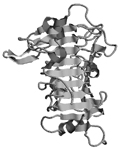 |
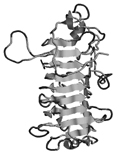 |
| The two images are protein structures. The one on the left is the product of experimental analysis of a protein sequence. The one on the right, which bears striking similarities, is a computer modeled image of the same protein sequence. | |
Thus comes computer modeling and PROSPECT, which uses algorithms to calculate the many variables a protein sequence presents. The Protein Structure group has used PROSPECT with one of ORNL’s new supercomputers, the IBM SP, to model protein structures. But it’s still time consuming.
“To solve these structures directly takes a long time,” Ying says. “It’s not practical to solve every protein, even with a supercomputer.”
But it’s here that nature offers researchers a break. About 10,000 protein structures to date have been solved, and from those solutions scientists have estimated that there are only about 1,000 or so unique structural folds in nature. This knowledge allows Ying and his colleagues to use a special approach called protein threading to fold proteins.
“We place a protein sequence onto a known structure and see if it’s a good match,” Ying says. “By using protein threading and matching with a known template, it takes only a few hours instead of months to solve one protein structure. And a few dollars, comparatively speaking.”
PROSPECT is far from 100 percent accurate, “yet,” as Ying says. But the recent, fourth CASP competition indicates that the software program in some instances comes very close to predicting the known shape of some protein sequences—good enough to place sixth out of 123 “useful” CASP4 entries. The Life Sciences group placed highest among DOE entries.
Protein structure modeling will enable scientists to take the information from the Human Genome Project and determine the function of genes from the proteins that they encode.
The modeling research is especially interesting to the bioscience community, particularly to pharmaceutical industry researchers. DOE also is interested. One of the Life Sciences group’s proposed projects with PROSPECT is to map the genomes of microorganisms that can ingest pollutants. Knowing exactly what it is about their genetic makeup that allows them to do that could be very valuable to the agency’s environmental restoration mission.
In the meantime, PROSPECT, which was developed with funding from DOE’s Office of Biological and Environmental Research, has become a licensed software product. The software prediction system runs on 184 nodes (each node has four processors) on the Lab’s IBM SP, which can thread up to 100 proteins a day against 2000 protein templates. ORNL’s expertise at modeling combined with its computational power positions the Lab to play a major role in the next step for the human genome project: structural genomics.
And if you’re one of those who worries that computers are becoming so advanced that they will soon dominate and control our lives, take comfort in the fact that the first-place winner of CASP4, Alex Murzin of Cambridge University, did his calculations in his head, without supercomputers.
More information about PROSPECT can be found at http://compbio.ornl.gov/structure/prospect/.—B.C.
 Parking: Plans allow for slots
Parking: Plans allow for slots“Will I get one of those new offices?” and “Where in blazes am I going to park?”
Lab planners can shed some light on question two.
New R&D buildings will occupy most of what is now the east parking lot, the Lab’s largest. Construction will also require major traffic pattern changes. ORNL officials recognized those facts from the outset and enlisted the firm of Barge Waggoner Sumner & Cannon to do a traffic study that began last fall.
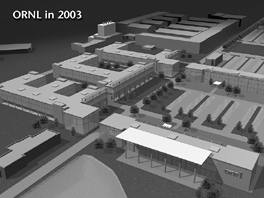 |
| If you put the October Reporter’s drawing of the new Lab on your refrigerator, replace it with this one. It’s the latest version of the east side, with the 4500 complex at top center. The forum building, which was sited near the main entrance, is now closer to the swan pond. The new plan preserves space for parking. |
“The first concern we heard from anybody and everybody was parking,” says the Facilities Revitalization Project’s Keith Dempsey.“We started looking early at where we could make up for lost spaces. Several initial approaches were studied: modify existing lots, create new ones, localize parking near buildings and, of course, devise an appropriate traffic pattern to get employees conveniently to a parking location. The overall intent was to provide a combination of large parking and smaller satellite areas, all of which meet both the city of Oak Ridge zoning requirements for parking and are a very short walking distance to employee work areas.”
Although the parking study looked at traffic and parking during and after construction, the immediate concern is for 2001 to 2004, during the construction of the new facilities on the east parking lot.
“Our studies are looking at how we should route traffic around the construction,” says Keith. “We’ll look at new entrances consistent with the open campus theme and, more importantly, find additional parking.”
New parking—estimates are that the Lab will realize a net gain of about 300 spaces—may include the area where the 6026 trailers are now, an expanded “flagpole lot” in front of Building 4500-North that will be accessible via Fifth Street from the north parking lot, and possibly a new lot on the recently filled retainment basins on the southwest end of the campus, with possibly better access across the creek from the current south parking lot. In addition, a revised traffic pattern, which would effectively create a south perimeter road, is being considered that would provide access from Bethel Valley Road to the new or expanded lots.
In the works are other plans that will affect traffic in and near the campus. They include traffic-calming measures such as islands or circles, improved signage and landscaping along Bethel Valley Road at ORNL. These improvements are intended to help slow down traffic on Bethel Valley Road, discourage commercial through-traffic and give drivers the notion that they have just arrived at “someplace special.”
The impression, Keith says, will be that “you’re entering a campus instead of driving by a plant.”
“No doubt there will be some inconveniences while construction is under way, but we are going to do everything we can to minimize disruption,” says Keith.—B.C.
 Quality of Work Life survey: Increase pension multiplier
Quality of Work Life survey: Increase pension multiplierTwo-thirds of ORNL staff members, presented with a chance to express their views on what they would most like to see improve at the Lab, took advantage of it. Ombudsman Steve Stow says the 2149 responses are “extraordinary,” giving the Leadership Team a clear idea of employee preferences.
“It shows a need,” said Lab Director Bill Madia at the January 18 Senior Staff Meeting.
Bill unveiled the top 10 preferences during the meeting. Increasing the pension multiplier was the top choice of 896 respondents, while 544 said they wanted to hear more from the Lab director himself.
Completing the top 10, with the number of respondents who preferred them overall, are
3. On-site fitness center: 497
4. Tuition reduction at UT and other “core” universities: 478
5. UT-Battelle matching contributions: 353
6. Improved physical facilities: 338
7. Personal use of frequent flyer benefits: 296
8. Financial planning assistance: 293
9. Phased retirement program: 289
10. Floating holidays: 283
Steve noted some trends in his initial analysis of the data. Some of them are logical.
“Interest in the pension multiplier increases with age,” he says. “On the other hand, interest in tuition assistance decreases with age, as people emerge from their academic years, as well as interest in a child care facility, which ranked at number 30, but very highly among employees ages 20 to 30.
“People also tended to vote their pocketbooks, with items relating to pensions, tuition, frequent flyer miles and financial planning ranking highly,” says Steve.
| Employees clearly desire better communication from management. |
Employees were very clear in their desire for better communication from management. Besides the desire for more messages from the Lab director, a call for more “all-hands” meetings just missed the top 10, placing at number 12. Increased contact with division managers placed at number 23. Enhanced communication on technical achievements ranked 16th, and a statement of values from UT-Battelle management ranked 25th.
Some staff desires are already being considered or acted upon. Madia and Human Resources and Diversity Programs Director Darryl Boykins said at the Senior Staff Meeting that some sort of pension benefit enhancement was being actively considered and could be enacted as soon as this summer. Vacated space is being considered for an on-site fitness center until a new facility can be built in the future, and jogging and walking trails (14th) are being considered for the New Campus Initiative. Improved physical facilities have been a goal of the UT-Battelle Leadership Team since they arrived on the job last April.
Several high-ranking staff priorities—such as floating holidays and frequent-flyer policy changes—can be achieved with minimal or even no cost, Steve points out.
Other wishes are more problematical. Tuition reductions, says Communications and Community Outreach Director Billy Stair, must be weighed with financial support the state has already made to ORNL in the form of tax relief for the Spallation Neutron Source and commitments in the tens of millions of dollars toward new facilities, all coming at a time when the state is struggling to raise revenue. Likewise, the limited resources available to UT-Battelle, combined with the $1.6 million obligation for the American Museum of Science and Energy, makes the fixed-fee contractor much less able to offer matching contributions, at least until the AMSE financial issues are resolved. “And we are working overtime on the AMSE,” says Billy (see Lab Notes, page 3).
UT-Battelle is currently putting together a scholarship program for students whose parents are ORNL employees.
Respondents’ most frequently written-in comment was to give more vacation time to new hires (the policy currently provides two weeks vacation for the first five years, which many view as a recruiting disincentive) while other write-ins were related to part-time employment issues.
Lab employees can look at the results of the QWL survey at the internal Web site at www-internal.ornl.gov/cind/lifesurvey/priorities.htm.—B.C.
 Briefs
BriefsThe mileage allowance for personal vehicle use during approved business travel, including local travel, has increased to 34.5 cents per mile, which matches the current 2001 standard IRS mileage rates.
W-2 statements for the year 2000 were mailed to ORNL employees in January. Employees who were on the payroll before April 2000 should have received two mailings; one statement from Lockheed Martin Energy Research and one from UT-Battelle. Any employees who have questions or did not receive their statements should contact Payroll Services at 574-9103.

 Home is where the X-rays are
Home is where the X-rays areDavid was called on to lead the SNS out of troubled waters two years ago, mainly on the strength of the reputation he gained for getting the APS efficiently completed. At an all-hands meeting of SNS staff shortly after the announcement, he said the lure of watching the APS bloom as a research facility was too strong to ignore.
David cited the “desire to stay close to the evolving science” at the APS as a factor that led him to choose Illinois over Tennessee. The APS, he said, is “on the verge of some extraordinary scientific productivity.” It is, after all, his baby.
He has commuted between labs and his family resides in Chicago. He has a son at Northwestern University.
David told the staffers he had “no concerns whatsoever” over the project’s prospects for completion.” ORNL Director Bill Madia, Dehmer and BES’s Iran Thomas all praised David for building support for the SNS throughout the science community and the government.
The search for his replacement is on a fast track. The ORNL director has put together a panel from some of the six participating labs to help him find a new executive project director, either from within the lab system or someone from the U.S. or international research community.
“We are looking for a person with a proven track record for building large, complex facilities on time and on budget,” Bill says, adding that he has already collected “a surprising number of highly qualified names.”
 Lab technologies pepper the 100 list
Lab technologies pepper the 100 list
When DOE set out to make a list of technologies that have improved the lives of consumers since Energy became a department in 1977, ORNL was able to respond in force. Of the 100 technologies they feature, 10 of them are ORNL technologies.
Two of those made a short list: R&D to improve refrigeration devices, from the Energy Division’s Buildings Technology Center, and Lab-on-a-Chip technology, led by the Chemical and Analytical Sciences Division’s Mike Ramsey. They received Energy@23 awards (23 years of DOE), selected by a citizen panel that judged them on their benefit to the American public, contribution to U.S. competitiveness in the global marketplace and potential for significant growth.
The other eight ORNL technologies that made the Energy 100 are
 AMSE hails its act of Congress
AMSE hails its act of CongressThe bill, passed late last month and signed into law by President Clinton on Decem-ber 21, is expected to help ensure the long-term financial stability of the precariously funded museum.
“You’d think such a bill would be easy to pass, but it was difficult,” said the congressman. Somewhere in the legislative process the on-the-surface “straightforward and simple” bill got a $400 million information technology bill attached to it, which threatened its passage.
Wamp, who was eventually able to get the amendment excised from the measure, expressed his own gratitude to folks like AMSE Program Manager Kaye Johnson, UT-Battelle leaders and Rep. Bart Gordon, who helped shepherd the bill through the House Science Committee.
 Researcher refuses to wash hands
Researcher refuses to wash hands
Computational Physics and Engineering Division researcher Jerry Dobson is also director of exploration for the American Geographical Society, which recently invited a noteworthy and famous group to sign the AGS’s symbolic Fliers’ and Explorers’ Globe. Jerry emceed the ceremony in New York City in December.
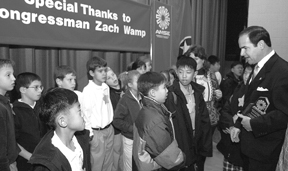 |
| Zach Wamp chats with of of two school groups that came to the AMSE to thank him for his efforts in Washington on behalf of the museum. |
Honorees included Don Walsh and Jacques Piccard (deepest ocean dive, 1960); Neil Armstrong (first man on the Moon, 1969); Bertrand Piccard (represented by his son) and Brian Jones (first circumnavigation of Earth by balloon, 1999); Bill Ryan (discovered 5,000,000-year-old Mediterranean Sea inundation and 7,500-year-old Black Sea inundation); and Walter Pitman (co-discovered Black Sea inundation).
The AGS’s globe has already been signed by the likes of Charles Lindberg, Amelia Earhart, Sir Edmund Hillary, Admiral Robert Peary, Matthew Hensen, Richard Byrd, Roald Amundsen, Wiley Post and John Glenn. (See it at www.geoplace.com/gw/1999/1199/1199gng.asp).
Jerry introduced moonwalker Armstrong to diver Walsh, which means he “had the rare privilege of introducing the man who went the deepest to the man who went the highest, an event that can only have happened once before (when Armstrong met Piccard) and can’t happen again unless someone lands on Mars and returns while Walsh and Piccard are still alive.”
| —Reported by Bill Cabage |
 Obesity-related gene in mouse discovered at ORNL
Obesity-related gene in mouse discovered at ORNL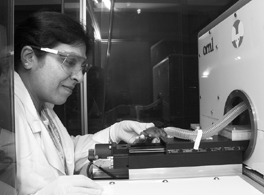 |
| Madhu Dhar, a postdoc fellow from the University of Tennessee, places a mouse into the MicroCAT system developed at ORNL. |
Some mice born at ORNL during the past holiday season have grown dangerously fat, even though they have been on a low-fat diet since birth. Although they do not appear overweight, these mice have a mutated gene that plays a strong role in causing obesity in the form of internal fat deposits that are hazardous to their health.
The gene was discovered by Madhu Dhar, postdoctoral fellow from the University of Tennessee working in the laboratory of Dabney Johnson, head of the Mammalian Genetics and Genomics section in ORNL’s Life Sciences Division.
“We have found that the normal mouse has a gene on chromosome 7 that probably plays a role in the transport of fat from the blood into fat cells, where fat is stored as a source of energy to keep the body healthy,” Johnson says. “If a mutant form of this gene is inherited from the mother in certain genetic backgrounds, the offspring grow 35 to 50 percent fatter by middle age than does a normal mouse, even though they are eating food low in fat.”
Unlike some known mouse obesity genes that can act all alone to cause excessive body fat, the ORNL researchers have shown that the chromosome 7 gene must act in concert with other genes involved in maintaining the body’s energy balance. If female mice possessing this mutated gene are mated with males having different genetic backgrounds, the offspring may not become obese, suggesting they have genes that code for proteins that suppress fat accumulation.
Humans and mice are genetically similar and produce similar proteins. In humans, chromosome 15 is similar to chromosome 7 in the mouse.
The ORNL group has been focusing on chromosome 7 in the mouse for some time. In the 1950s ORNL geneticists Bill and Liane Russell irradiated mice and observed that some of their offspring who survived had a pinkish coat and pink eyes instead of normal gray-brown fur pigmentation and dark eyes. It was later determined that the radiation knocked out DNA from a coat-color gene, called the pink-eye marker (p), on mouse chromosome 7. Neighboring genes also were deleted or altered in some irradiated mice, and the defects were passed on.
Thanks to the availability of improved technologies, ORNL researchers have defined the small region on mouse chromosome 7 that contains the p gene and its neighbors. Using recombinant DNA techniques, they identified and characterized genes from this small region in the normal mouse. In mutant mice they have identified behavioral oddities, internal defects and disorders such as epilepsy and obesity caused by the absence or alteration of certain neighboring genes on chromosome 7. From this information on genetic material gone awry, they can determine the function of the normal genes in this chromosome region.
Johnson says that, like humans, mice deposit fat in their bodies in different patterns that are genetically controlled. This distribution of fat deposits in mice with the obesity gene has been observed in three dimensions by Mike Paulus and Shaun Gleason in ORNL’s Instrumentation and Controls Division. They have imaged internal fat deposits in mice using the MicroCAT miniature X-ray computerized tomography system they developed. Using special software, they have determined the size and weight of those fat deposits.
Dhar’s research was funded by the National Institutes of Health, and the findings were published in a paper in a recent issue of Physiological Genomics. —Carolyn Krause
 New management systems:
clearing up workplace confusion
New management systems:
clearing up workplace confusion| by FAY FREDERICK |
“Will it change the way we operate as a Laboratory?”
“Will it improve our policies, procedures and guidelines?”
“Will it better define my roles and responsibilities?”
“Will it reduce costs?”
“Will it make my job easier?
Yes, yes, yes, yes and yes!
You could say that operating our Laboratory by management systems is a second stage of our initial re-engineering efforts. Converting to management systems will enable us to follow through with those improvements as well as others. Management systems are designed to support the research we do as a Laboratory and provide a product our R&D customer wants and needs. That’s what re-engineering is all about.
| We often wade through long and confusing policies, procedures and guidelines usually developed as a response to audits or auditors, not for the staff who use them. |
Management systems will change the way we operate as a Laboratory. They are similar to what we currently call functional policy areas, but are fully integrated with emphasis on the work process rather than organizational alignment. When developed and approved, the complete set of management systems will define how we do business at ORNL.
Converting to management systems will clarify and streamline our policies and procedures, making it much easier for staff to perform their work. We often wade through long and confusing policies, procedures and guidelines usually developed as a response to audits or auditors, not for the staff who use them. But before we can even wade through these documents, we must find them. This is no easy task. They are located in multiple areas on the Web, in hard-copy manuals, in division specific documents, etc. With SBMS, all documents are located on a single Web site and written in simple, clear and concise language, which saves valuable time and reduces frustration for the user. SBMS procedures developed and used at other labs are about one-fourth the size of our current procedures and provide step-by-step instructions for the user.
Management systems will improve the way we manage our R&D business and make us very competitive in today’s market. Other labs have achieved remarkable results and cost savings using this approach.
What is SBMS? The Standards-Based Management System provides the infrastructure needed for us to document and deploy all other management systems. It is also the tool we use to manage and document our contract requirements and management expectations and convert those requirements into easy-to-use documents for the staff. Documents for SBMS are designed with extensive stakeholder involvement, thus making them extremely accurate and very usable on the job.
We will also need to collect and streamline our policies for use in SBMS. We currently have policies in ORNL directives, division procedures, office guides and in many other areas. During the initial phase of SBMS development, we have collected about four notebooks full of policies and policy statements, many of which I did not know existed—and I have worked with requirements for 10 years! It is difficult to comply with requirements that you don’t know exist.
SBMS will also clearly define staff roles and responsibilities, which currently are extremely difficult to gather from the scattering of policies, procedures and job descriptions. During SBMS development, Human Resources and your division management will assess a complete set of staff roles and responsibilities and will further define the authority and accountability of staff in carrying out their roles and responsibilities.
The new acronym for defined roles, responsibilities, authorities and accountabilities is (R2A2s). R2A2s, along with other planned improvements through SBMS, will greatly improve our understanding of what is needed to continue to perform as a world-class R&D laboratory.
If you haven’t had an opportunity to attend one of the SBMS orientation training sessions, I encourage you to do so. We will be offering additional sessions in the near future and will advertise them on ORNL Today and through your division training officer. If you would like additional information regarding management systems or SBMS, call Fay Frederick at 576-1460 or Teresa Childs at 576-5388.
The Office of Training Services’ Fay Frederick is leading the training campaign for management systems.
 Lab researchers’ detection system may help stop tree-killing beetle
Lab researchers’ detection system may help stop tree-killing beetleLarvae from the beetles, which are native to China and Korea, are inadvertently imported into the United States nestled inside the wood of shipping crates containing a host of products. Within days of their arrival, beetles are out boring into trees, where they lay eggs. The larvae start eating the tree’s cambium, the layer that generates new cells, disrupting its nutrient-transporting vessels.
 |
| A close-up of the hardwood- munching Asian longhorned beetle |
Eventually, the trees die. It’s a problem that has a lot of people concerned.
“These beetles, which grow to more than an inch in length, can cause billions of dollars in damage to forests and to the maple syrup, lumber and tourism industries,” said Cyrus Smith of the Instrumentation and Controls Division.
(These beetles are different from the southern pine beetles that have ravaged stands of pine trees on the Oak Ridge Reservation. The ORR’s nemesis is a native species that takes advantage of favorable conditions to infest pine forests.)
The Asian longhorned beetles’ favorite U.S. targets are maples, horsechestnuts, black locusts, elms, birches, willows and poplars. Already, they have infested thousands of trees in New York and Chicago. The only effective means to eliminate the beetle is to cut infected trees and destroy them by chipping or burning.
Visual inspection of crates and trees is difficult and ineffective, so Smith and colleagues at ORNL are developing a hand-held instrument that identifies the vibrations made by the larvae as they feed on the wood. Their goal is to develop an instrument that can distinguish the Asian longhorned beetle larvae from other insects and identify the larvae at different stages of maturity.
To develop the instrument, Smith, Glenn Allgood and Dale Treece, also of the I&C Division, are gathering vibration data from these beetles and other insects as they feed. Researchers are analyzing the information and developing algorithms—mathematical solutions to solve complex problems—to help identify the presence of telltale characteristics.
“We’ll then incorporate these algorithms into a prototype instrument that can detect the bugs and determine if the infestation is by the Asian longhorned beetle,” Smith said.
Initial results gained with acoustic sensors and a laptop computer loaded with the algorithms are encouraging.
“Our algorithms have been successful in detecting larvae in sample logs and in trees in natural settings,” Smith said, “but we still need to analyze data from various larvae stages, different woods and different insects to see if our algorithms can discriminate these effects.”
Researchers have discovered that because young larvae feed at the wood-bark interface, where the material is softer, the vibrations are smaller in amplitude. Older larvae feed on the interior wood and produce larger amplitude vibrations, which are easier to detect. This is significant and should help in detecting larvae at ports of entry because crating material is made from interior wood that contains more mature larvae.
Once the operation and accuracy of the prototype instrument have been documented in the field, the technology will be transferred to an industrial partner for commercialization and miniaturization.—Ron Walli
 REDC, HFIR get spacecraft fuel role
REDC, HFIR get spacecraft fuel roleIt means, for ORNL, a long-term program that is expected to be funded at up to $12 million a year for the forseeable future, says Bob Wham of the Radiochemical Engineering Development Center. REDC, which will process targets irradiated at Idaho National Engineering and Environmental Laboratory’s Advanced Test Reactor and at ORNL’s High Flux Isotope Reactor, could realize up to $40 million in improvements to the facility.
“Over next several years we’ll put in production capacity to make the targets, then later to do the chemical processing to recover the Pu-238 oxide, which will be shipped to Los Alamos, where they make the fuel pellets,” Bob says.
The record of decision signed January 19 ends a long decision process that also considered restarting the Fast Flux Test Reactor at Hanford, which will now be permanently deactivated.
ORNL’s role in the NASA deep-space missions goes back several years. The Lab has been involved in the manufacture of the reactor thermal generators that contain the Pu oxide fuel, and the iridium alloy that safely encapsulates the fuel was developed in the Metals and Ceramics Division.—B.C.
 Noted ORNL physicist P.R. Bell dies
Noted ORNL physicist P.R. Bell diesP.R. started a career at ORNL that began in 1946 and continued until he retired in 1978, except for a stint at NASA’s Lunar Receiving Laboratory in Houston, where he was in charge of analyzing samples brought back from the Apollo moon missions.
He won the Langstreth Medal for his pioneering work in nuclear medicine and, according to Director Emeritus Alvin Weinberg, was one of the first to suggest that carbon dioxide was being produced by the melting of methane hydrates.
P.R.’s work in improving scintillation instruments for detecting radiation levels and energies—a great boon to the field of dosimetry—was also applied to medical uses. The medical scanners physicians and patients depend on so much today have their beginnings with P.R. Bell’s improved scintillation spectrometers.
James H. Todd
Friends and relatives note the death, on November 20, of James H. Todd of Lenoir City. Jim worked at ORNL from 1959 to 1991, most of the time in the then Neutron Physics Division. He was 69.
He helped design control systems for the Oak Ridge Electron Linear Accelerator and the American Museum of Science and Energy and electronics for an electron accelerator at Rensselaer Polytechnical Institute in New York. One of his earlier systems was used for radiation monitoring throughout ORNL.
 Tax help available from VITA
Tax help available from VITAIRS-trained volunteers will be available to provide free tax assistance from 3 to 8 p.m. every Monday through Friday and on Saturdays from 10 a.m. to 12:30 p.m. No appointment is necessary. Free e-filing is available.
Those seeking help in preparing their income tax returns should bring their tax package and their W-2 forms, their 1099 statements and other tax records, including last year’s return, with them.
Retirees John Murray and Mike Lundin are the Oak Ridge coordinators of this free public service program.
 ORNL people
ORNL peopleWill Minter, manager of the Small Business Program Office in the Business and Information Services Directorate, was named “Chamber Volunteer of the Year 2000” at the Oak Ridge Chamber of Commerce’s annual business meeting, held January 18. Representing ORNL, Will led the revitalization of the Annual Business Opportunity Conference.
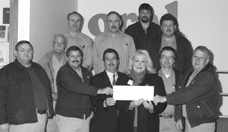 |
| The Plant and Equipment team that won an Awards Night “of the year” award donated their prize to the Ronald McDonald House. Team members who helped Lab Director Bill Madia (center) present the $2,000 check to RMH’s Sue Beverly are (front row, left) J.D. Gibson, Bruce Walker, Gary Wright, Jim Ayers, (back row) Gene Kitchens, Rambo Sexton, Larry Brummette, Mike Richmond and Jack Crawford. |
The Chemical Technology Division’s Bill Steele has been reappointed to the editorial board of the ACS Journal of Chemical & Engineering Data for a three-year term. Bill has also accepted a three-year appointment to the Journal of Chemical Thermodynamics’ editorial board. Finally, he has joined the canvassing committee of the ACS E.V. Murphree Award in Industrial and Engineering Chemistry, sponsored by ExxonMobile Research and Engineering Company and ExxonMobile Chemical Company, for a three-year appointment.
Stephen E. Nagler of the Solid State Division was recently elected to fellowship in the American Physical Society by the Division of Condensed Matter Physics. He was cited “for neutron scattering studies of excitations in low-dimensional quantum magnets.”
Steve Pennycook, corporate fellow in the Solid State Division, has received the Thomas Young Medal and Prize from the Institute of Physics for his electron microscopy work. The award is presented in London.
Energy Division’s Debbie Bain has been awarded a citation from Dr. Ashish Sen, director of the Bureau of Transportation Statistics, “in recognition of her service to the BTS in supporting the Journal of Transportation and Statistics,” the Department of Transportation’s only scholarly periodical.
Phil Jardine was an invited presenter at the Soil Science Society of America symposium Soil Carbon Sequestration Research: Foundation for National Policy. His presentation, “Hydrologic and Geochemical Processes Controlling the Transport and Sequestration of Natural Organic Matter in Soil,” drew a standing-room-only crowd.
The Environmental Sciences Division’s Meng-Dawn Cheng and members of his team including Da-Ren Chen (Univ. of Minnesota), Che-Jen Lin (Lamar Univ.), Madhavi Martin, Gordon Miller (Life Sciences Division) and Thomas Wainman (ORAU) were awarded the Project of the Year award from SERDP (the Strategic Environmental Research and Development Program). They shared the award with a Sandia researcher.
The Life Sciences Division’s Toxicology and Risk Analysis section received a citation from the U.S. Army Center for Health Promotion and Preventive Medicine recently in recognition of the their “tremendous contributions” towards improved science and Army policy on health issues related to chemical warfare agents. The team includes Annetta Watson, Dennis Opresko, Robert Young, Robert Ross and Po-Yung Lu. Po-Yung also was acknowledged for his contributions toward developing an “outstanding working relationship” between ORNL and the Army center, which is increasingly recognized as an “exemplary model of superb intergovernmental cooperation.”
ORNL office: P.O. Box 2008, Oak Ridge, TN 37831-6146, Building
4500-S, Room F-60, MS 6146
ORNL help line (ethics; fraud, waste and abuse; quality; ES&H)
576-9000
[an error occurred while processing this directive]
[an error occurred while processing this directive]
Bill Cabage, lead editor, ORNL, 574-4399 (cabagewh@ornl.gov)
Deborah Barnes, associate editor, 576-0470 (barnesds@ornl.gov)
Ombudsman: 576-7802
DOE inspector general hotline: 1-800-541-1625